Folks do a little bit of this and a little bit of that to get by. The scale is smaller. The range of tasks that a person has to master is much greater than a factory job. The person working gigs must be a bookkeeper, a coach, a doctor. They must also master the art of merchandizing or retailing.
Retail Lighting
Retail lighting is closely related to display and packaging. Consequently, I am going to write about all three of those topics as if there was no functional difference between them.
Spoiler: Intense, Point light sources!
People are hard-wired to respond to changes in sensory input. We are less responsive to magnitude than we are to rates of change.
From
an evolutionary biology standpoint, picture a woman walking across the
primordial plains. She is carrying a baby and a large "cigar" that
carries the community fire. She is keeping an eye on her older children
as they wander across the plains. She is looking for edible seeds and
tubers as she walks.
Now,
suppose that there is a disturbance in the tall grass. Something very
large is moving directly toward her at a high rate of speed. Or perhaps
something that looked like a large fleshy root moves a scant half inch.
The
humans that did not respond at the speed of the sub-conscious were
removed from the gene pool. We are hard-wired to respond to changes faster than conscious thought.
What does this mean to lighting in the retail environment?
Picture
the typical, exhausted shopper walking by this display. As they walk
parallel to this display, is there any "new" information? Is there
anything that grabs them and triggers their hard-wiring?
Nope.
Backstory
I
blog. I am into nature and trees and all that stuff. In the middle of
winter I can identify sassafras trees from half a mile away while
driving down a freeway at seventy miles away.
I
have taken HUNDREDS of pictures attempting to capture the essence of
sassafras trees and have utterly failed. I failed, abjectly and
miserably, to capture the unique traits of sassafras trees. I never
even came close.
Finally,
it occurred to me. While driving at seventy miles an hour I can look
at a cluster of trees in a fence row for a quarter second and I
unfailingly create an accurate, three-dimensional map of the structure
of the tree. The unique trait of the sassafras tree is that the lateral
limbs are exactly horizontal and the twigs at the end of the branches
point up nearly vertical. The unique trait is three-dimensional!
For
the total technical geek, this strategy of three dimensional mapping is
exploited in Synthetic Aperture RADAR, by Phased Array RADAR and by
Towed Sonar Arrays. This is 1980's technology.
Why?
Why
do people pay $1500 for a diamond but won't spend a $1 for a ring with a
piece of frosted glass? Why do many people adore black opals?
Diamonds sparkle. Opals shimmy. They capture our attention.
The opposite of diamonds is diffuse, muddy light. Yeah, ambient fluorescent lighting.
How can a retailer tickle the hard-wiring?
First
of all, strip 75% of the product off the shelf. Spacing out the
product presents the consumer with an ever-changing, isometric view of
the product as the travel down the aisle. Your display shelf should not be a warehouse!
Second, third and fourth, INTENSE
single point lighting. If you have ever messed around with lighting
you know that single point lighting creates shadows and shading, the
basis of three-dimensionality. Sufficient intensity creates kind of an
X-Ray vision where depth of product is plumbed. Think about an
exquisitely varnished wooden musical instrument or a much-loved
automobile with thirty coats of candy-apple-red paint.
Products
that are transparent or translucent can be BACK-LIT! The bottles or
jars act as lenses; the light will sparkle or clock as the consumer
moves past. The consumer will be incapable of ignoring this product. IT IS IN THEIR GENES!
Their vestigial survival instincts will force them to invest cognitive resources in "mapping" this product.
In
many cases, the increased dwell time will result in an emotional !BELL!
being rung: "Hey, I remember this product. It is delicious!"
Touch-down! You just made a sale.
In
other cases, a heuristic involving sunk cost will kick in. The
customer's mind will conflate "cognitive resources invested" with "I am
interested in this product but cannot remember exactly why." That
customer has a higher probability of putting your product in their
shopping cart and trying it. If they try it they might decide that they
like it.
Getting fancy
Ok,
we stripped 70% of the product off the shelf but now we cannot keep the
shelves stocked because it is moving too fast. Damned if you do,
damned if you don't.
The following discussion is focused on transparent and translucent products...
What
if one were to place a row of product near the edge of the shelf and
the "pitch" of the product was such that the gap from item-to-item was
65% of the depth of the container. Now, picture a flat, LED strip
behind that facade of product with integral lens to back-light the
produce. Behind the LED strip are three or four rows of product that
can be moved to the facade position.
The
jars or bottle of (honey, jelly, wine, juice, herbed vinegar, olive
oil....) will glow and sparkle as the consumer cruises down the aisle.
Will the consumer be "impulsed" to buy these products...or the bottles
of BBQ sauce shown in the top picture?
The key is to make the "visual" change as the customer walks down the aisle.


No comments:
Post a Comment
Readers who are willing to comment make this a better blog. Civil dialog is a valuable thing.